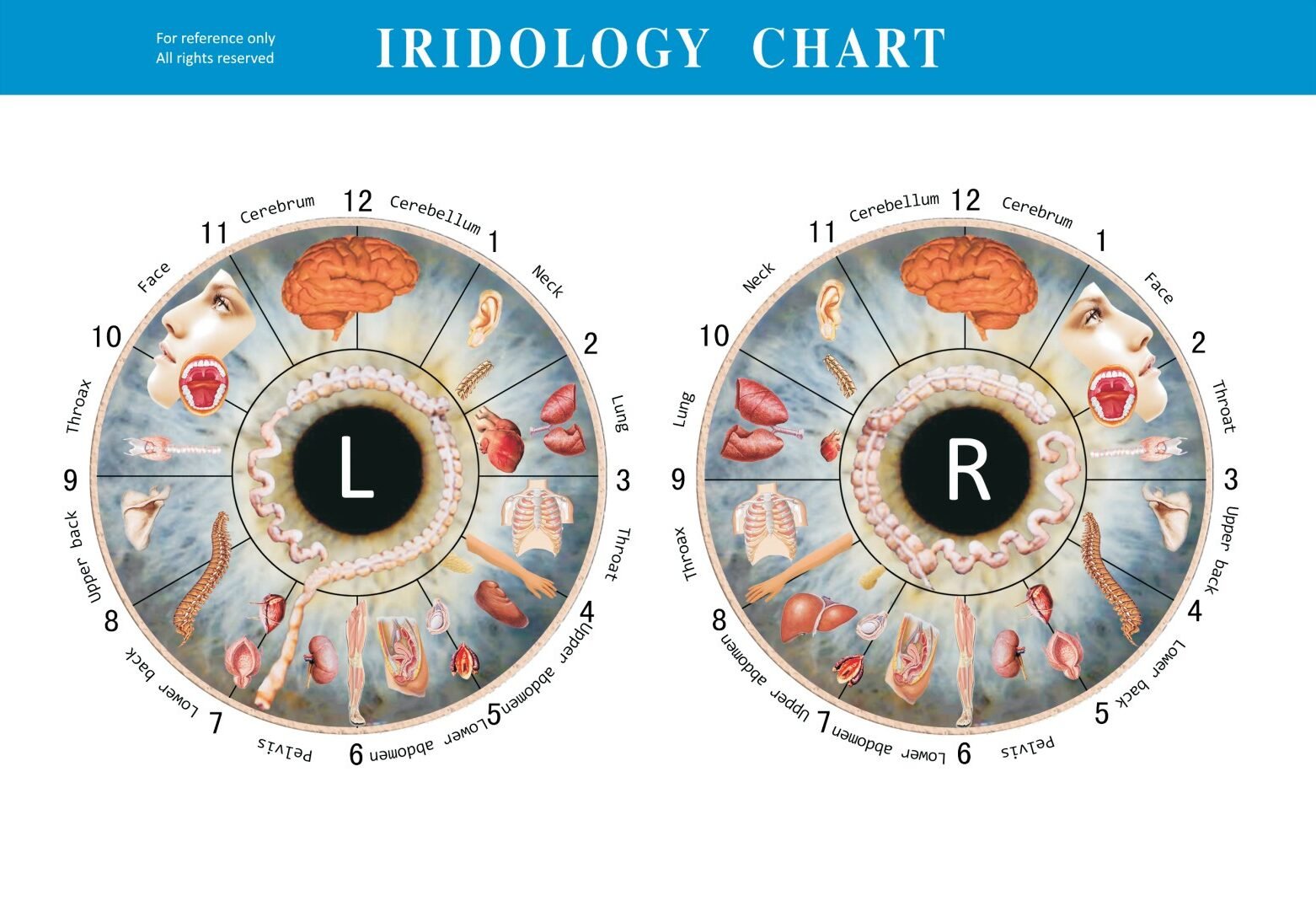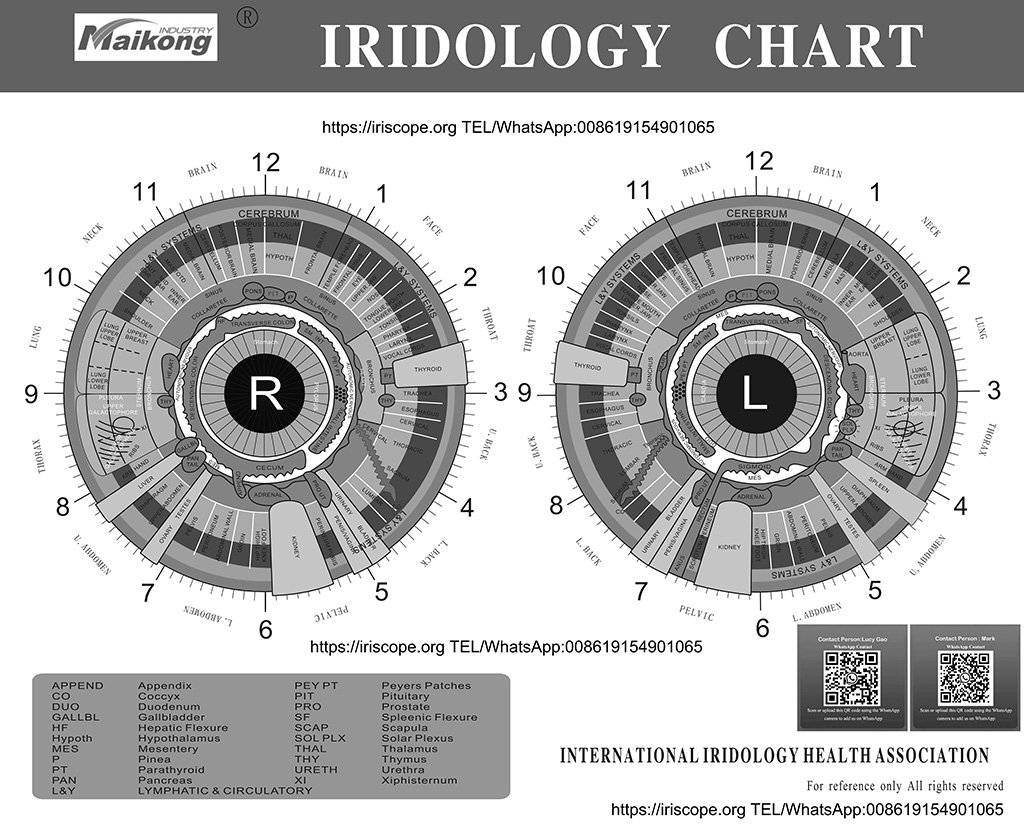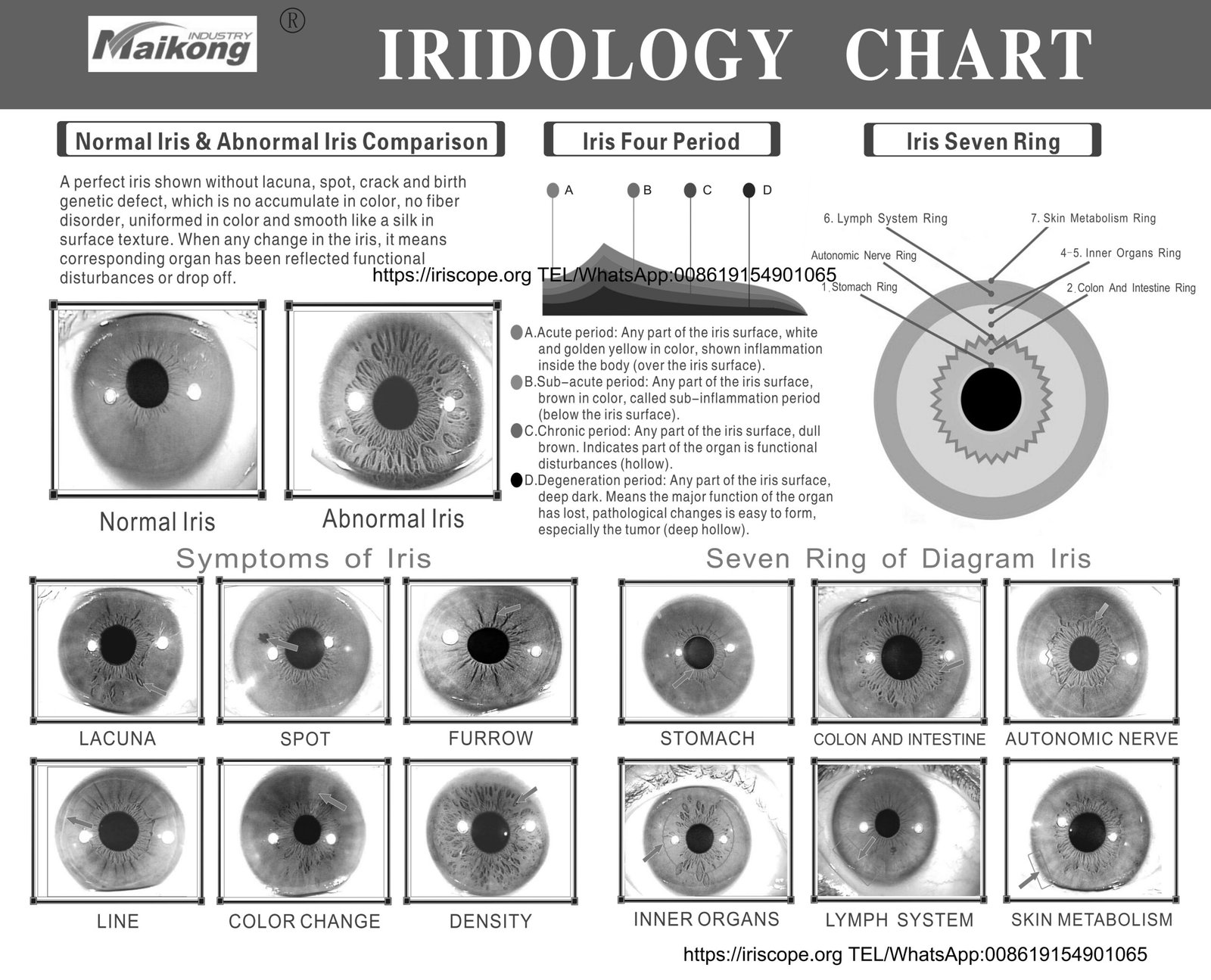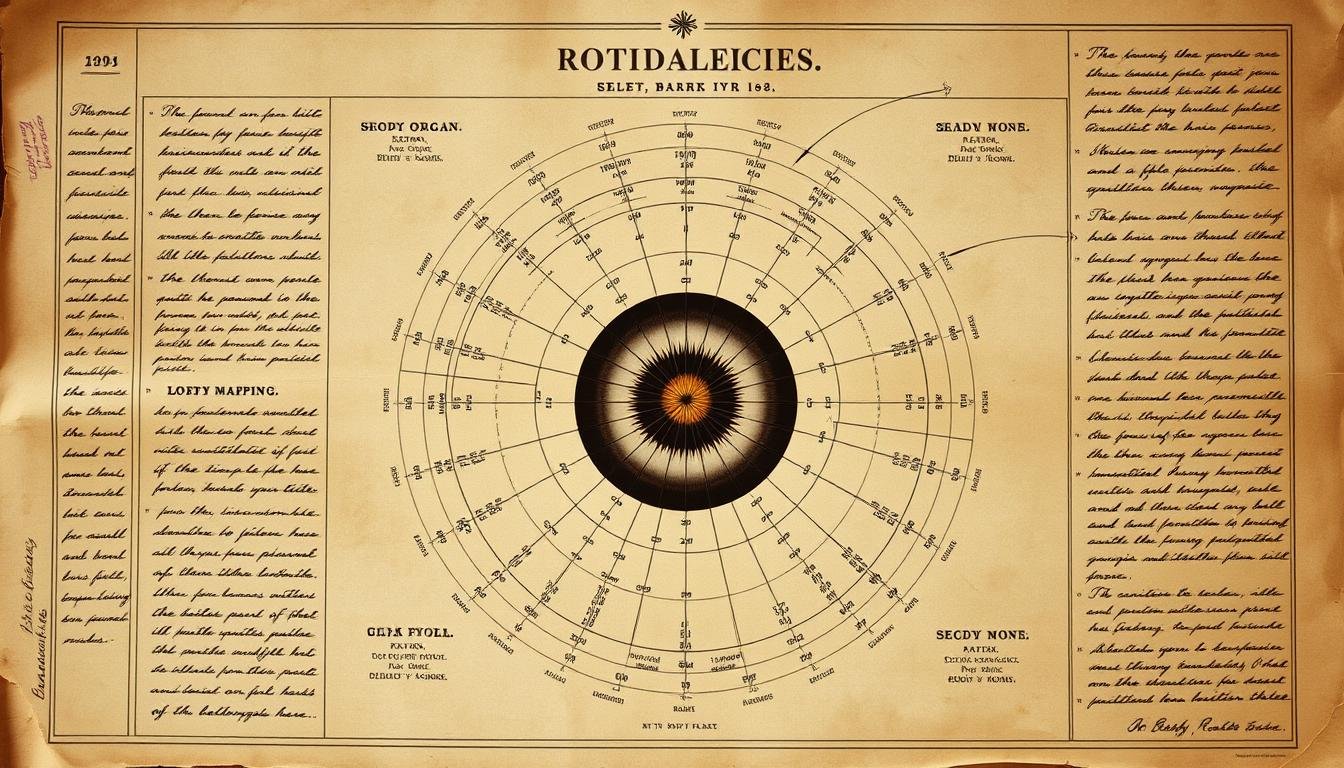A antiga prática de analisar a íris para obter informações sobre a saúde fascina os profissionais há séculos. Leitura de Iridologia é um método de avaliação não invasivo que examina os padrões, cores e características da íris para identificar possíveis condições de saúde e pontos fortes constitucionais. Este guia abrangente explora a ciência, a metodologia e as aplicações da análise da íris nas práticas modernas de saúde holística.
O Desenvolvimento Histórico de Leitura de Iridologia





Gráfico de iridologia inicial desenvolvido no século 19 mostrando correlações entre íris e órgãos
As raízes da iridologia remontam a milhares de anos em civilizações antigas no Egito, China e Índia, onde os médicos observaram conexões entre marcas oculares e condições de saúde. No entanto, moderno iridologia tal como a conhecemos hoje começou a tomar forma no século XIX.
O momento crucial no desenvolvimento da iridologia ocorreu quando o médico húngaro Dr. Ignatz von Peczely fez uma observação notável quando criança. Depois de quebrar acidentalmente a perna de uma coruja, ele notou uma marca escura distinta aparecer na íris do pássaro. Esta observação despertou a sua curiosidade, levando-o a estudar a relação entre as marcas da íris e as condições físicas. Em 1881 von Peczely publicou seu trabalho inovador, “Descobertas no campo da ciência e medicina naturais: instrução no estudo do diagnóstico do olho,” que incluiu o primeiro gráfico abrangente de mapeamento de regiões do corpo para áreas específicas da íris.
No início do século 20, o Dr. Bernard Jensen desenvolveu e popularizou a iridologia nos Estados Unidos, criando gráficos detalhados da íris que ainda são amplamente utilizados hoje. Sua abordagem sistemática Leitura de iridologia estabeleceu muitos dos princípios fundamentais que os profissionais seguem na prática moderna.
A base científica da análise da íris
A base científica da iridologia baseia-se na compreensão de que a íris contém milhares de terminações nervosas conectadas ao cérebro através do nervo óptico e do hipotálamo. Esta rede neural cria uma conexão biológica entre a íris e vários sistemas do corpo através do sistema nervoso.
A íris consiste em estruturas complexas e interconectadas, incluindo:
- Milhares de fibras nervosas
- Vasos sanguíneos
- Tecido muscular
- Tecido conjuntivo
- Células de pigmentação
De acordo com a teoria da iridologia, essas estruturas refletem mudanças nos tecidos corporais correspondentes através do sistema nervoso. Quando os tecidos do corpo apresentam inflamação, toxicidade ou congestão, essas condições podem se manifestar como alterações visíveis em áreas específicas da íris.
Pesquisas recentes utilizando tecnologia avançada de imagem começaram a explorar essas conexões de forma mais sistemática. Um estudo de 2013 publicado no IEEE Journal of Biomedical and Health Informatics demonstrou correlações entre alterações na íris e na pupila e certos distúrbios digestivos, sugerindo potencial mérito científico para alguns princípios da iridologia.
“A íris contém uma riqueza de informações sobre os nossos pontos fortes e fracos constitucionais. Cada íris é tão única quanto uma impressão digital, revelando características herdadas e potenciais tendências de saúde.”
– Dr. Bernard Jensen, Pioneiro da Iridologia Moderna
Um profissional Leitura de iridologia segue uma abordagem sistemática para garantir uma análise precisa e abrangente. Veja como o processo normalmente se desenrola:
1. Preparação de Equipamentos
O iridologista prepara equipamentos especializados para o exame, que podem incluir:
- Iriscópio – um dispositivo de ampliação especializado com iluminação
- Câmera digital com capacidade de lente macro
- Software de iridologia para análise digital
- Gráficos de referência e materiais de documentação
2. Histórico e Consulta do Cliente
Antes de examinar a íris, uma consulta minuciosa reúne informações relevantes:
- Histórico médico e preocupações atuais com a saúde
- História de saúde familiar
- Fatores de estilo de vida (dieta, exercícios, níveis de estresse)
- Medicamentos e suplementos atuais
3. Exame da Íris
O exame real envolve a observação cuidadosa de ambas as íris:
- O cliente senta-se confortavelmente com iluminação adequada
- Cada íris é examinada separadamente, normalmente primeiro o olho direito
- Fotografias digitais podem ser tiradas para análise detalhada
- O praticante observa cor, estrutura e marcações
4. Mapeamento e análise de gráficos
O iridologista mapeia as observações em um gráfico iridológico:
- Correlacionando zonas da íris com sistemas corporais correspondentes
- Identificando marcações, cores e padrões
- Observando áreas de potencial preocupação ou força
- Comparando resultados entre íris esquerda e direita
5. Interpretação e Recomendações
A fase final envolve explicar os resultados e sugerir ações apropriadas:
- Explicando observações em termos compreensíveis
- Discutindo possíveis implicações para a saúde
- Sugerir modificações no estilo de vida, se apropriado
- Recomendar avaliações de acompanhamento, se necessário
Nossa equipe fornece avaliações iridológicas abrangentes usando equipamentos de última geração. Entre em contato conosco para saber mais sobre nossos serviços ou para agendar sua leitura.
Agende sua leitura
Métodos de interpretação de gráficos de iridologia



Gráfico de iridologia moderno mostrando a correlação entre zonas da íris e sistemas corporais
A interpretação de um gráfico iridológico requer a compreensão do complexo sistema de mapeamento que conecta zonas específicas da íris aos sistemas corporais correspondentes. Os gráficos iridológicos padrão dividem cada íris em aproximadamente 60 seções, criando um mapa detalhado do corpo.
A Topografia da Íris
A íris é normalmente dividida em várias zonas principais:
| Zona de íris |
Correlação Corporal |
Foco na Interpretação |
| Zona Pupilar (Interna) |
Sistema digestivo, estômago |
Saúde digestiva, absorção de nutrientes |
| Zona Ciliar (Médio) |
Órgãos principais, glândulas |
Função orgânica, atividade metabólica |
| Zona Periférica (Externa) |
Pele, circulação, linfáticos |
Eliminação, eficiência de circulação |
| Collarette (coroa de nervos autônomos) |
Sistema nervoso |
Resposta ao estresse, equilíbrio autonômico |
Os iridologistas profissionais procuram marcadores específicos que indiquem várias condições:
Indicadores de cores
- Branco: Inflamação ou atividade aguda
- Amarelo: Desafios renais ou urinários
- Laranja: Problemas de fígado ou vesícula biliar
- Marrom: Congestão ou toxicidade hepática
- Preto: Danos ou degeneração dos tecidos
Indicadores Estruturais
- Raios Solares: Radiações tóxicas indicando irritação
- Lacunas: Lesões fechadas mostrando fraqueza inerente
- Criptas: Lesões abertas indicando condições agudas
- Pigmentos: Manchas coloridas mostrando depósitos químicos
- Anéis: Padrões circulares indicando estresse ou tensão
O processo de interpretação requer considerar tanto a localização como o tipo de marcação. Por exemplo, uma lesão aguda branca na área pulmonar pode indicar inflamação activa no sistema respiratório, enquanto uma lacuna escura na mesma área pode sugerir uma fraqueza inerente ou uma condição crónica que afecta os pulmões.
Nota importante: A iridologia é considerada uma ferramenta complementar de avaliação e não um método diagnóstico para doenças específicas. Os resultados devem ser correlacionados com outras informações de saúde e avaliações médicas.
Embora a medicina convencional tenha demorado a adotar a iridologia, a prática continua a evoluir e a encontrar aplicações em vários ambientes de saúde, particularmente no âmbito da medicina complementar e alternativa.
Avaliação Preventiva de Saúde
Uma das aplicações mais valiosas do iridologia está na saúde preventiva. Ao identificar fraquezas constitucionais e potenciais áreas problemáticas antes do desenvolvimento dos sintomas, os profissionais podem recomendar modificações específicas no estilo de vida e medidas preventivas.
Ferramenta de avaliação complementar
Muitos profissionais de saúde holísticos usam a iridologia como um componente de uma avaliação abrangente de saúde, juntamente com outras modalidades, como:
- Avaliação nutricional
- Exame físico
- Análise do histórico de saúde
- Teste funcional
Planejamento de bem-estar personalizado
Informações coletadas de um Leitura de iridologia pode ajudar os profissionais a desenvolver protocolos de bem-estar altamente personalizados que abordem as tendências constitucionais específicas e vulnerabilidades potenciais de um indivíduo.
Monitorando o progresso da saúde
Alguns profissionais utilizam avaliações iridológicas sequenciais para monitorar mudanças no estado de saúde ao longo do tempo, particularmente ao implementar intervenções nutricionais ou de estilo de vida.
Abordagem Tradicional
- Exame manual com ferramentas de ampliação
- Referência de gráfico de papel
- Interpretação subjetiva
- Capacidade de documentação limitada
Abordagem Moderna
- Imagens digitais com câmeras de alta resolução
- Análise assistida por computador
- Protocolos de interpretação padronizados
- Documentação digital abrangente
Atualize sua clínica com equipamento profissional de iridologia
Oferecemos iriscopios, câmeras digitais e software de análise de última geração para profissionais de saúde. Nossos equipamentos são utilizados por profissionais em todo o mundo.
Explore nossos equipamentos
Contato via WhatsApp
Equívocos comuns sobre iridologia
Apesar da sua longa história e prática contínua, a iridologia enfrenta vários equívocos que podem levar a mal-entendidos sobre o seu propósito e limitações.
Fatos sobre iridologia
- A iridologia é uma ferramenta de avaliação, não um método de diagnóstico
- Identifica tendências constitucionais, não doenças específicas
- A iridologia profissional requer treinamento e equipamento adequados
- Funciona melhor como parte de uma avaliação de saúde abrangente
- Abordagens modernas incorporam avanços tecnológicos
Equívocos sobre Iridologia
- A iridologia pode diagnosticar doenças específicas
- Pode substituir o diagnóstico médico convencional
- A íris muda rapidamente com condições de saúde
- Qualquer pessoa pode praticar iridologia sem treinamento
- Não tem qualquer base científica
Compreender essas distinções é crucial tanto para profissionais quanto para clientes. Os iridologistas profissionais reconhecem os limites da sua prática e trabalham dentro de uma estrutura ética que enfatiza a avaliação complementar em vez do diagnóstico de doenças.
“A iridologia não pretende diagnosticar doenças, mas sim identificar pontos fortes e fracos constitucionais, permitindo abordagens preventivas direcionadas antes que os sintomas se desenvolvam.”
Quando abordada com compreensão adequada e expectativas realistas, a iridologia pode fornecer informações valiosas como parte de uma avaliação holística da saúde. No entanto, nunca deve substituir os cuidados médicos adequados ou atrasar a procura de tratamento para problemas de saúde graves.
Perguntas frequentes sobre Leitura de Iridologia
O que pode um Leitura de iridologia revelar sobre minha saúde?
Uma leitura da iridologia pode revelar pontos fortes e fracos constitucionais, áreas potenciais de inflamação ou congestão, tendências inerentes a certas condições e integridade geral do tecido. Ele fornece informações sobre as predisposições do seu corpo, em vez de diagnosticar doenças específicas.
É Leitura de iridologia comprovado cientificamente?
A iridologia tem validação científica limitada na pesquisa médica convencional. Embora alguns estudos mostrem correlações promissoras entre as marcações da íris e certas condições de saúde, são necessárias mais pesquisas. A prática baseia-se em correlações observadas ao longo de muitos anos de prática clínica, em vez de extensos estudos controlados.
Quanto tempo dura um Leitura de iridologia pegar?
Uma leitura abrangente da iridologia normalmente leva de 30 a 60 minutos. Isso inclui a consulta inicial, o exame de ambas as íris, a análise por meio de gráficos iridológicos e a discussão dos resultados. As sessões de acompanhamento são geralmente mais curtas, concentrando-se em áreas específicas de interesse ou monitorando mudanças.
Pode Leitura de iridologia substituir o diagnóstico médico?
Não, a leitura da iridologia não pode e não deve substituir o diagnóstico médico adequado. É uma ferramenta de avaliação complementar que fornece informações adicionais sobre tendências constitucionais e potenciais áreas de preocupação. Sempre consulte profissionais de saúde qualificados para diagnóstico e tratamento de condições médicas.
Que equipamento é necessário para profissionais Leitura de iridologia?
A iridologia profissional requer equipamento especializado, incluindo um iriscópio (um dispositivo de ampliação com iluminação adequada), câmeras digitais de alta resolução com recursos macro, software de análise de iridologia e gráficos de referência. Equipamentos de qualidade garantem a observação precisa dos detalhes da estrutura da íris.
Tem mais perguntas sobre iridologia?
Nossa equipe de especialistas está pronta para responder às suas perguntas sobre leituras, equipamentos ou treinamentos em iridologia. Contate-nos hoje para saber mais.
Envie um e-mail para nossos especialistas
Abraçando os insights da iridologia
A iridologia oferece uma janela única para a compreensão das tendências constitucionais de saúde e potenciais áreas de preocupação. Embora continue a ser visto com ceticismo por alguns na medicina convencional, muitos profissionais de saúde holísticos encontram valor na sua capacidade de fornecer insights sobre os pontos fortes e fracos inerentes.
A prática de Leitura de iridologia evoluiu significativamente a partir de suas raízes históricas, incorporando tecnologia moderna e abordagens padronizadas, mantendo seus princípios fundamentais. Quando praticado por profissionais treinados e utilizando equipamentos de qualidade, pode servir como um componente valioso de uma avaliação abrangente da saúde.
Quer você seja um profissional de saúde interessado em adicionar a iridologia à sua prática ou um indivíduo curioso sobre o que seus olhos podem revelar sobre sua saúde, abordar a iridologia com uma perspectiva informada e equilibrada irá ajudá-lo a obter o máximo benefício deste fascinante método de avaliação.
Pronto para explorar o mundo da iridologia?
Oferecemos equipamentos profissionais de iridologia, recursos de treinamento e leituras personalizadas. Entre em contato conosco para saber como podemos apoiar sua jornada de saúde ou prática profissional.
Contate-nos hoje

























